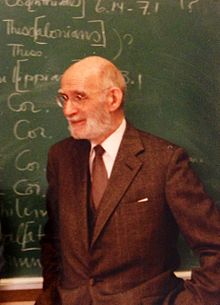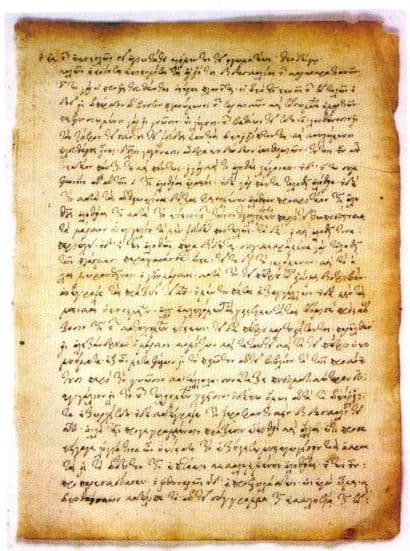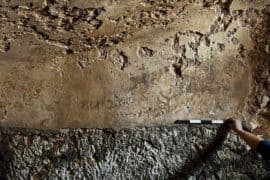There has been a lot of discussion over the past 45 years regarding the late Columbia University historian Morton Smith and his discovery, publication, and interpretation of a so-called “Secret Gospel of Mark” in 1973. According to Smith, fifteen years earlier he had come across, quite by accident, a copy of a letter of Clement of Alexandria at the Greek Orthodox monastary of Mar Saba, southeast of Jerusalem, in which Clement quoted portions of a version of the Gospel of Mark that contained additions to our canonical Mark that he, Clement, considered authentic. Thus the term “Secret Mark.” According to Clement these special additions were not to be shared with all, but only with those initiated into the mysteries of the Christian faith. The clear implication was that there were two versions of the Gospel of Mark circulating in Clement’s time (early 3rd century AD), one for public distribution–presumably the version we all have today in our Bibles, and the other only to be shared with those who could understand and accept some of the deeper teachings of the “mysteries” of Christianity. Unfortunately, for us at least, Clement only quoted two short portions of “Secret Mark,” so that is all that is available to us today. Smith not only considered these materials early and authentically from Mark’s original gospel, but he saw them as providing a glimpse into an underground form of Christianity, shared only with initiates, that had much to say about the real Jesus and his earliest followers. The implications of this approach to the historical Jesus and early Christianity Smith lays out in detail in his subsequent classic, Jesus the Magician (HarperCollins 1978).

I well remember the storm of controversy Morton Smith stirred in the Fall of 1973 with the publication of both his scholarly tome from Harvard University Press titled Clement of Alexandria and a Secret Gospel of Mark, as well as his popular summary thereof, The Secret Gospel: The Discovery and Interpretation of the Secret Gospel According to Mark (Harper, 1973; republished in 2005 by Dawn Horse Press with a lovely introduction by Elaine Pagels). Both volumes remain valuable to this day, but Smith’s massive 454 page Harvard study is indispensable to students of ancient magic and religion in the Hellenistic Mediterranean world. It is about much more than the letter of Clement, although a thorough linguistic and historical analysis of his discovery is at the core of the book.
I was at the University of Chicago at the time, just beginning my Ph.D. work at the young age of 27. I will never forget how the late Norman Perrin did an oral review of the Harvard volume for the weekly faculty/student forum in the Divinity School and castigated Smith in the harshest terms imaginable for his sloppy sensationalism, even hinting, way back then, that maybe Smith had “forged” the document himself. It was clear that Smith had stirred up much more than the proverbial bee in a bonnet. I immediately ordered copies of both books, straining my fledgling student book budget. Those two volumes are treasured to this day.

The authenticity of Smith’s text of Clement was generally accepted by scholars and has made its way into numerous critical works and sources, see, for example, the links at the Early Christian Writings web site under “Secret Mark.” The controversy among experts was generally over Smith’s interpretation thereof, rather than seriously questioning the authenticity of the text itself. More recently, however, with the publication of attorney Stephen Carlson’s The Gospel Hoax (Baylor University Press, 2005), and Peter Jeffrey’s The Secret Gospel of Mark Unveiled (Yale University Press, 2006), any number of scholars have joined the “forgery” bandwagon, so that the issue of whether Morton Smith might have forged the document itself is clearly out on the table.
Scott G. Brown wrote the first doctoral dissertation on the Secret Gospel of Mark in 1999 while studying religion at the University of Toronto. He has published numerous articles on the subject, as well as a book, Mark’s Other Gospel: Rethinking Morton’s Smith Controversial Discovery (Waterloo, Ontario: Wilfrid Laurier University Press, 2005). His definitive summing up article, “On the Composition History of the Longer (‘Secret’) Gospel of Mark,” Journal of Biblical Literature 122 (2003), pp. 89–110, is a good overview of the issues of forgery and authenticity.
The Biblical Archaeology Review (November/December 2009) has a four part special feature that summarizes the case for and against forgery, including positive assessments by Hedrick and Koester that I find wholly convincing, plus an persuasive “lawyerly” editorial by Hershel Shanks, “Secret Mark”: Restoring a Dead Scholar’s Reputation.”
There is also Roger Viklund’s impressive paper, “Tremors, or Just an Optical Illusion? A Further Evaluation of Carlson’s Handwriting Analysis” you can read on-line here. There is also shorter summary blog post by Viklund provided by Timo S. Paananen here with some comments and responses worth reading as well–particularly Stephan Huller’s humor!
Anthony Grafton, “Gospel Secrets: The Biblical Controversies of Morton Smith,” published in The Nation (January 7, 2009) argues against the forgery thesis but on new evidence taken from Smith’s recently published correspondence with his life-long friend, the great Jewish scholar Gershom Scholem. These letters make it clear beyond any reasonable doubt that Smith could not have forged either Clement’s letter or the passages of “Secret Mark” contained therein. The manner in which Smith’s own views and understanding of his discovery develop and change over time are clearly demonstrated in these letters, as he debates with himself the significance of the text he has found and shares his insights and his questions with Scholem. Indeed, Grafton argues that Smith’s interpretation of the Markan passages, and his subsequent conclusions regarding Jesus as a libertarian “magician,” were largely influenced by his relationship with Scholem. I commend Anthony Grafton for publishing such a clear and useful article that in my estimation goes a long way in setting the record straight.
As of now the manuscript discovered by Smith, brought to Jerusalem to the Greek Patriarchate Library for photographing, and seen by several scholars, including Guy Stroumsa and the late Hebrew University professors David Flusser and Shlomo Pines, has disappeared. I think it is likely that unknown individuals at the Patriarchate Library may be withholding the pages, or even destroyed them, since Morton Smith’s homoerotic interpretation of the text was so controversial and threatening.
Discussions of the possible relevance of the texts Smith called “Secret Mark” to our understanding of Jesus and the character of his movement will continue but I for one think we will be far ahead to drop the unfounded speculations that Morton Smith forged the texts themselves.
A Final Personal Reflection:
I knew Morton Smith reasonably well for close to twenty years, from my student days at Chicago until his death in 1991. Based upon our correspondence and many hours of face-to-face discussions over the years I have always been utterly convinced that the charge Smith forged this text was absurd, completely without basis, and blatantly disrespectful of the scholar I knew him to be. I continue to maintain that no one who truly knew Morton Smith and worked with him over the years would think him capable of such behavior.
Morton Smith’s devotion to my dissertation project was remarkable considering he was at Columbia and had nothing officially to do with Chicago or my committee (I wrote under Jonathan Z. Smith with Robert M. Grant and Bernard McGuinn as readers. Smith loved ideas and recognized in my fledgling attempts to enter the field of “Jewish magic,” a beginning scholar who wanted to produce something of quality. He spent hours heavily annotating my dissertation chapters and wrote me these wonderful handwritten notes with citations and suggestions that I treasure to this day. I will never forget when a photo-copy of the manuscript of Sefer HaRazim arrived in the mail, prior to it being available in print, compliments of Prof. Smith. He would not even let me pay him for the copy costs or postage. Over the next twenty years we often spent time together at the annual meetings and on other occasions and he came to visit us when I was teaching at the College of William and Mary in 1986. He was a regular participant and contributor to the SBL seminar I co-directed over the years dealing with Greco-Roman idea of the “Divine and the Human.” I can honestly say that I honored, respected, and loved Morton Smith, as a scholar, a colleague, and a friend.









Comments are closed.